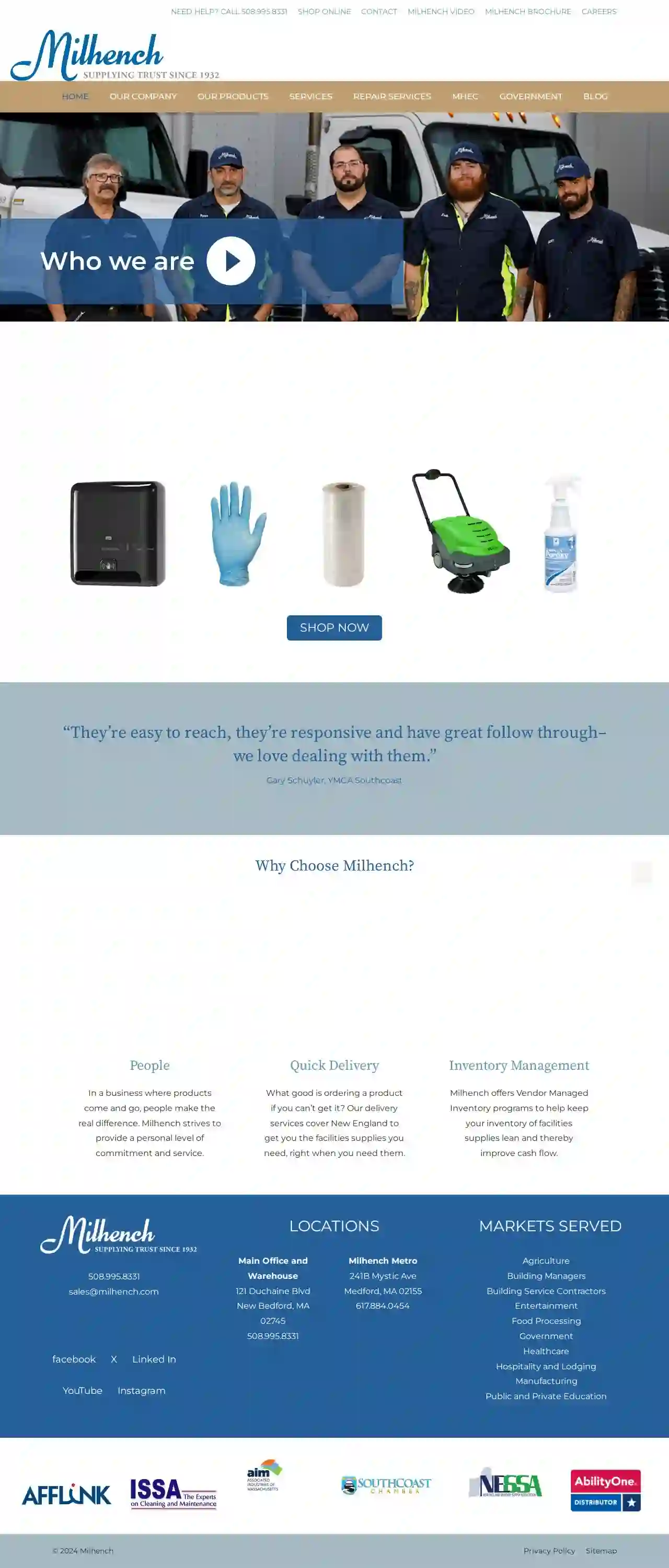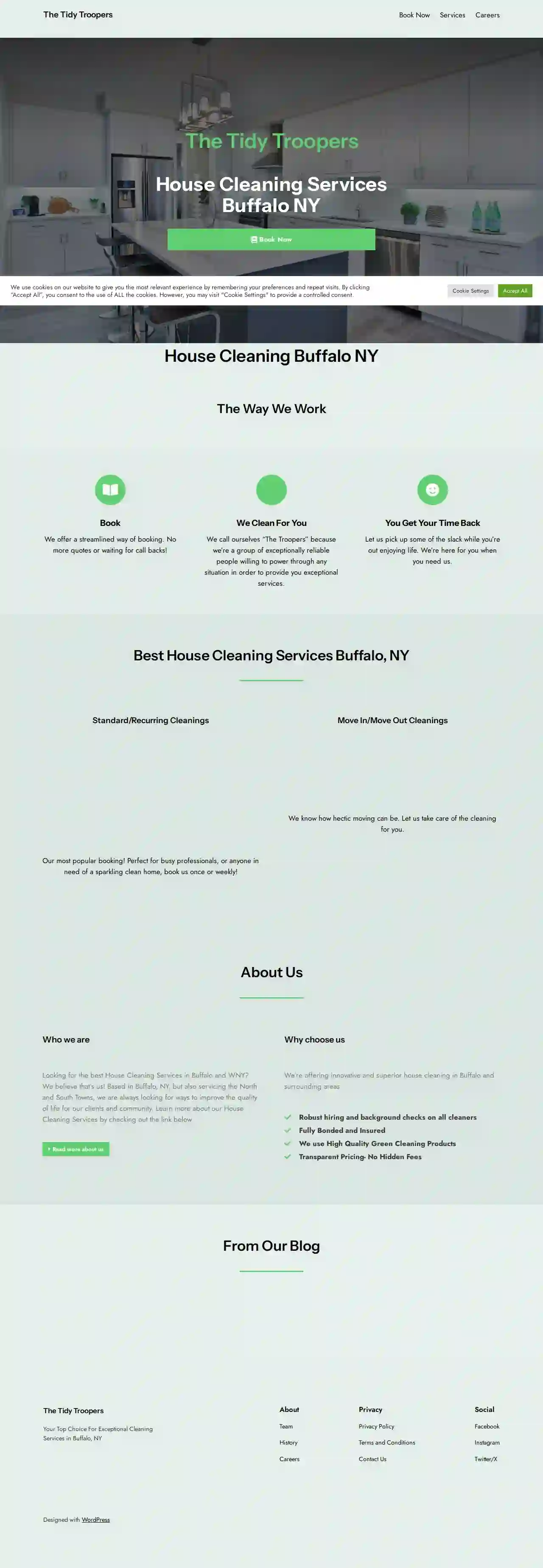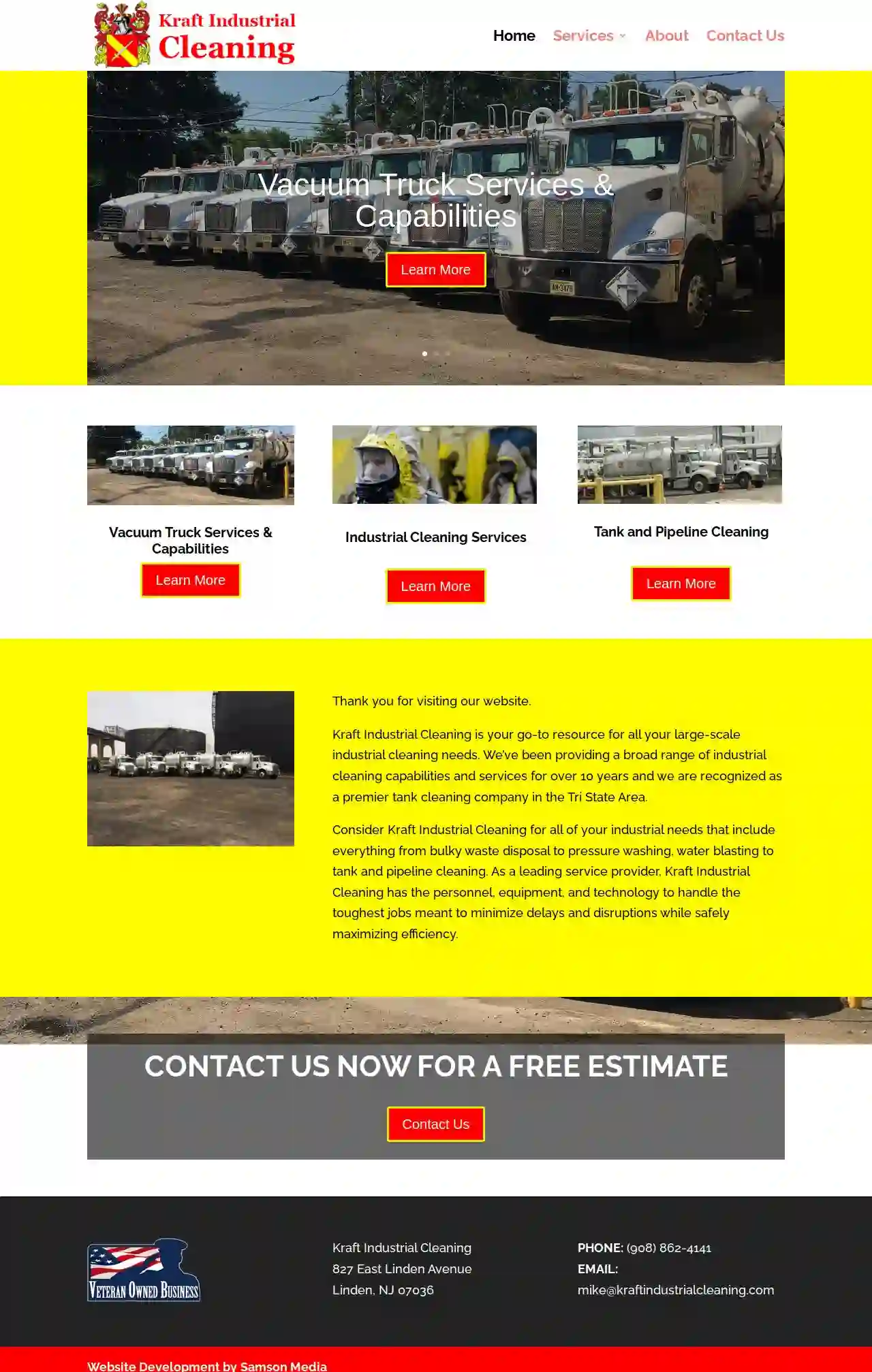Cleaning Services Hamilton
Best House Cleaning in Hamilton
Receive 3 FREE Home Cleaning quotes for your project today! Compare profiles, reviews, accreditations, portfolio, etc... and choose the best service.

Milhench Supply Co
4.36 reviews121 Duchaine Blvd, New Bedford, 02745, USMilhench is a family-run business that has been providing everyday necessities to keep businesses running cleanly and efficiently for over three generations. With a mission to deliver dependability, Milhench offers a personal level of commitment and service, quick delivery, and inventory management programs to help improve cash flow. They serve various markets including Agriculture, Building Managers, Building Service Contractors, Entertainment, Food Processing, Government, Healthcare, Hospitality and Lodging, Manufacturing, Public and Private Education.
- Services
- Why Us?
- Accreditations
- Our Team
- Testimonials
- Gallery
Get Quote
UpstateNY Commercial Cleaning
55 reviewsSyracuse, US- Services
- Why Us?
- Gallery
Get Quote
The Tidy Troopers Cleaning
4.8136 reviews123 Clean St, Buffalo, NY, 14201, USThe Tidy Troopers is a house cleaning service based in Buffalo, NY, offering superior cleaning services to the North and South Towns. They believe in improving the quality of life for their clients and community. Their services include standard/recurring cleanings and move in/move out cleanings. They use high-quality green cleaning products, are fully bonded and insured, and have robust hiring and background checks on all cleaners. They also offer transparent pricing with no hidden fees.
- Services
- Why Us?
- Accreditations
- Our Team
- Testimonials
- Gallery
Get Quote
Syracuse Cleaning Services
57 reviewsSyracuse, US- Services
- Why Us?
- Gallery
Get Quote
Gateway Cleaning Services
550 reviewsSuite 1, 9703 Gravois Rd, St. Louis, 63123, USGateway Cleaning Services offers premier cleaning services as part of the Titan Pest & Wildlife Solutions family, specializing in commercial and residential settings. We ensure that every space looks pristine and is conducive to a healthy, productive environment. Our mission is to provide peace of mind through superior cleaning services, enhanced by our integrated pest management and property maintenance approach, ensuring your spaces remain pristine and healthful. We prioritize our clients' needs, offering customized services tailored to their requirements. We use eco-friendly cleaning methods and products to ensure environmental safety and sustainability. We are reliable and consistent in our service delivery, ensuring our clients' peace of mind. We conduct our business with the utmost professionalism and ethical standards.
- Services
- Why Us?
- Accreditations
- Our Team
- Testimonials
- Gallery
Get Quote
Alba Cleaning Services
510 reviewsBronx, US- Services
- Why Us?
- Gallery
Get Quote- Al
Alecia's Cleaning Service
4.723 reviewsPoughkeepsie, US- Services
- Why Us?
Get Quote 
Commercial & House Cleaning Glen Ridge
55 reviewsStaten Island, US- Services
- Why Us?
Get Quote
Kraft Industrial Cleaning
4.52 reviewsStaten Island, US- Services
- Why Us?
Get Quote
Ms. Donna's Cleaning Service
54 reviewsBronx, US- Services
- Why Us?
Get Quote
Over 60,241+ Janitorial Companies registered
Our janitorial companies operate in Hamilton & beyond!
CleaningMatch has curated and vetted Top Janitorial Services arround Hamilton. Find a trustworthy pro today.
Frequently Asked Questions About Cleaning Services
- Regular dusting: Dust frequently using microfiber cloths or a duster. Pay attention to surfaces that attract dust, such as shelves, electronics, and furniture.
- Vacuuming: Vacuum carpets and rugs regularly using a vacuum cleaner with a HEPA filter to trap dust mites and allergens.
- Air Purifier: Consider using an air purifier to remove dust particles and allergens from the air.
- Reduce Clutter: Clutter provides more surfaces for dust to settle. Declutter regularly to minimize dust traps.
- Window Treatments: Wash or vacuum window treatments, such as curtains or blinds, regularly to remove dust buildup.
- Bedding: Wash bedding, including sheets, pillowcases, and blankets, weekly in hot water to remove dust mites.
- Doormats: Place doormats at entrances to trap dirt and dust from shoes before they enter your home.
- Blot, don't rub: When treating fresh stains, blot with a clean cloth or paper towel to absorb as much of the stain as possible. Rubbing can spread the stain and damage carpet fibers.
- Club Soda: For spills like wine or coffee, pour club soda on the stain, let it fizz, then blot with a clean cloth. Repeat if needed.
- Vinegar Solution: Mix equal parts white vinegar and water, apply to the stain, and blot. Vinegar helps remove stains and odors.
- Baking Soda Paste: Make a paste with baking soda and water, apply to the stain, let it dry, then vacuum. Baking soda absorbs odors and lifts stains.
- Commercial Carpet Cleaner: : Use a commercial carpet cleaner according to the instructions. Choose a cleaner specifically designed for the type of stain you're dealing with.
- Professional Carpet Cleaning: For stubborn or deeply set stains, consider hiring a professional carpet cleaning service. They have specialized equipment and expertise in stain removal.
- Experience and a proven track record: Choose companies with a solid history of providing quality cleaning services.
- Positive customer reviews and testimonials: Check online reviews and ratings to gauge customer satisfaction.
- Licensed and insured professionals: Ensure the company has the necessary licenses and insurance to protect you from liability.
- Clear and transparent pricing: Obtain detailed quotes and compare prices from multiple companies.
- Good communication and responsiveness: Choose a company that communicates clearly, responds promptly, and addresses your concerns.
- Declutter Regularly: Set aside time regularly to declutter your belongings. Donate, sell, or discard items you no longer use or need.
- Designated Storage: Assign specific storage spaces for different items, such as shelves for books, drawers for clothes, and containers for toys.
- Labeling: Label storage containers and drawers to make it easy to find items and put them back in their designated places.
- 'One In, One Out' Rule: For every new item you bring into your home, get rid of an old one. This prevents clutter from accumulating.
- Vertical Storage: Utilize vertical storage solutions, such as shelves, wall organizers, and hanging racks, to maximize space.
- Digital Organization: Organize digital files and emails to reduce paper clutter. Use cloud storage services to free up space on your computer.
How do I prevent dust from accumulating in my home?
By implementing these preventive measures, you can significantly reduce dust accumulation and maintain a cleaner and healthier home.
How can I get rid of tough stains on carpets?
Always test any cleaning solution on a small, inconspicuous area of the carpet first to ensure it doesn't cause discoloration or damage.
How do I find a good cleaning service?
Utilize online directories like CleaningMatch to find and compare qualified cleaning services in your area.
What are some tips for keeping my home organized and clutter-free?
By adopting these strategies, you can create a more organized and clutter-free home, promoting a sense of calm and efficiency.
How do I prevent dust from accumulating in my home?
- Regular dusting: Dust frequently using microfiber cloths or a duster. Pay attention to surfaces that attract dust, such as shelves, electronics, and furniture.
- Vacuuming: Vacuum carpets and rugs regularly using a vacuum cleaner with a HEPA filter to trap dust mites and allergens.
- Air Purifier: Consider using an air purifier to remove dust particles and allergens from the air.
- Reduce Clutter: Clutter provides more surfaces for dust to settle. Declutter regularly to minimize dust traps.
- Window Treatments: Wash or vacuum window treatments, such as curtains or blinds, regularly to remove dust buildup.
- Bedding: Wash bedding, including sheets, pillowcases, and blankets, weekly in hot water to remove dust mites.
- Doormats: Place doormats at entrances to trap dirt and dust from shoes before they enter your home.
By implementing these preventive measures, you can significantly reduce dust accumulation and maintain a cleaner and healthier home.
How can I get rid of tough stains on carpets?
- Blot, don't rub: When treating fresh stains, blot with a clean cloth or paper towel to absorb as much of the stain as possible. Rubbing can spread the stain and damage carpet fibers.
- Club Soda: For spills like wine or coffee, pour club soda on the stain, let it fizz, then blot with a clean cloth. Repeat if needed.
- Vinegar Solution: Mix equal parts white vinegar and water, apply to the stain, and blot. Vinegar helps remove stains and odors.
- Baking Soda Paste: Make a paste with baking soda and water, apply to the stain, let it dry, then vacuum. Baking soda absorbs odors and lifts stains.
- Commercial Carpet Cleaner: : Use a commercial carpet cleaner according to the instructions. Choose a cleaner specifically designed for the type of stain you're dealing with.
- Professional Carpet Cleaning: For stubborn or deeply set stains, consider hiring a professional carpet cleaning service. They have specialized equipment and expertise in stain removal.
Always test any cleaning solution on a small, inconspicuous area of the carpet first to ensure it doesn't cause discoloration or damage.
How do I find a good cleaning service?
- Experience and a proven track record: Choose companies with a solid history of providing quality cleaning services.
- Positive customer reviews and testimonials: Check online reviews and ratings to gauge customer satisfaction.
- Licensed and insured professionals: Ensure the company has the necessary licenses and insurance to protect you from liability.
- Clear and transparent pricing: Obtain detailed quotes and compare prices from multiple companies.
- Good communication and responsiveness: Choose a company that communicates clearly, responds promptly, and addresses your concerns.
Utilize online directories like CleaningMatch to find and compare qualified cleaning services in your area.
What are some tips for keeping my home organized and clutter-free?
- Declutter Regularly: Set aside time regularly to declutter your belongings. Donate, sell, or discard items you no longer use or need.
- Designated Storage: Assign specific storage spaces for different items, such as shelves for books, drawers for clothes, and containers for toys.
- Labeling: Label storage containers and drawers to make it easy to find items and put them back in their designated places.
- 'One In, One Out' Rule: For every new item you bring into your home, get rid of an old one. This prevents clutter from accumulating.
- Vertical Storage: Utilize vertical storage solutions, such as shelves, wall organizers, and hanging racks, to maximize space.
- Digital Organization: Organize digital files and emails to reduce paper clutter. Use cloud storage services to free up space on your computer.
By adopting these strategies, you can create a more organized and clutter-free home, promoting a sense of calm and efficiency.